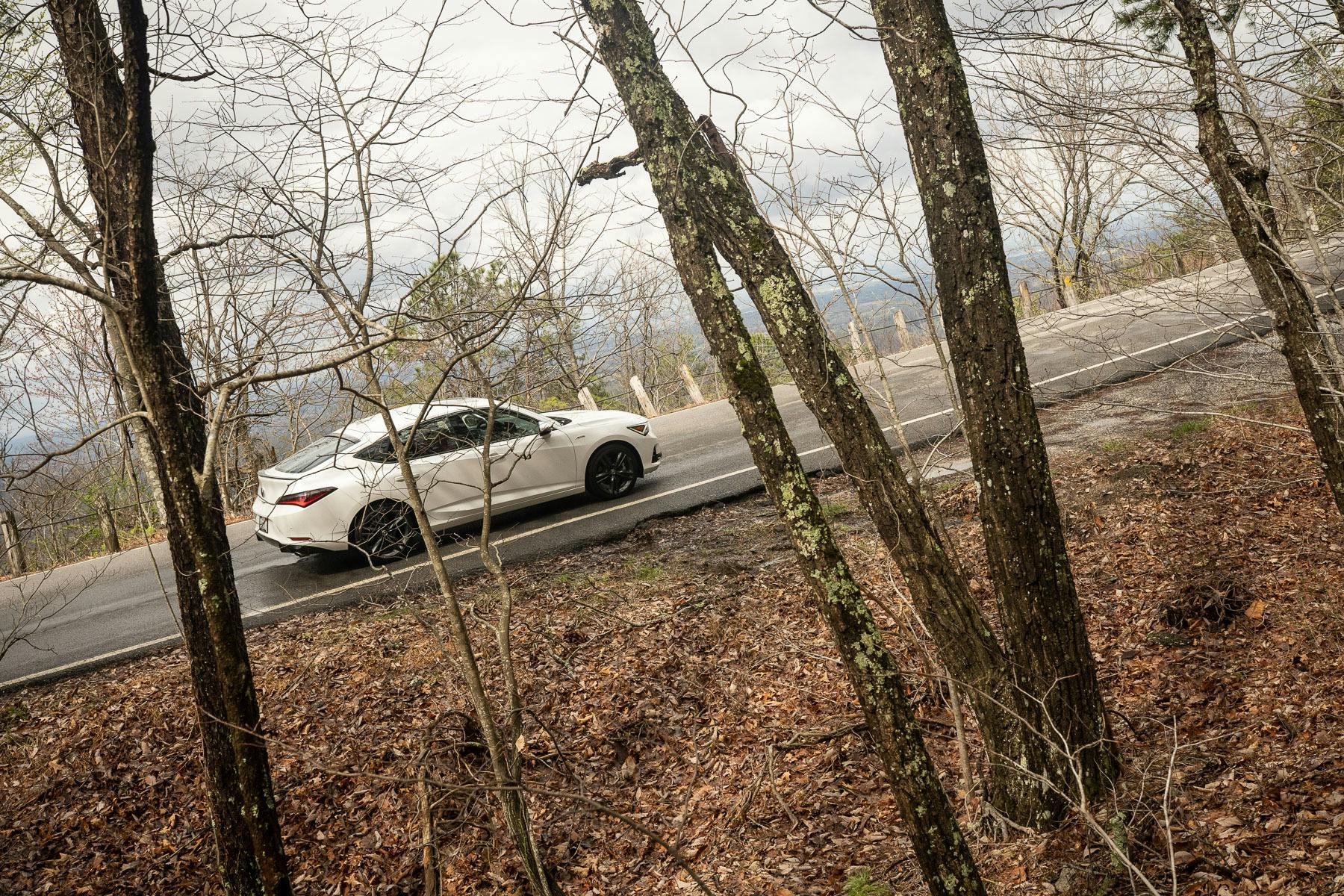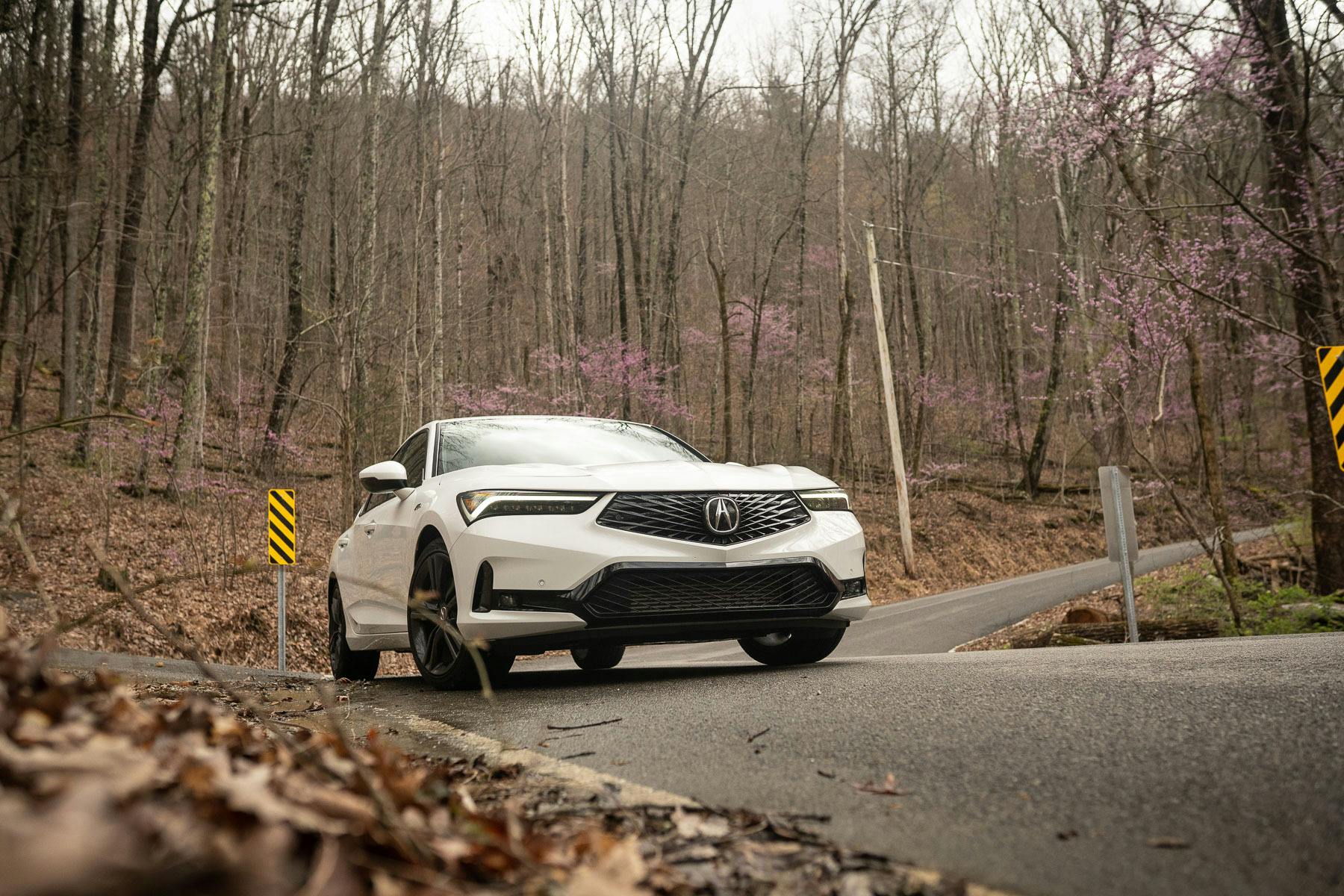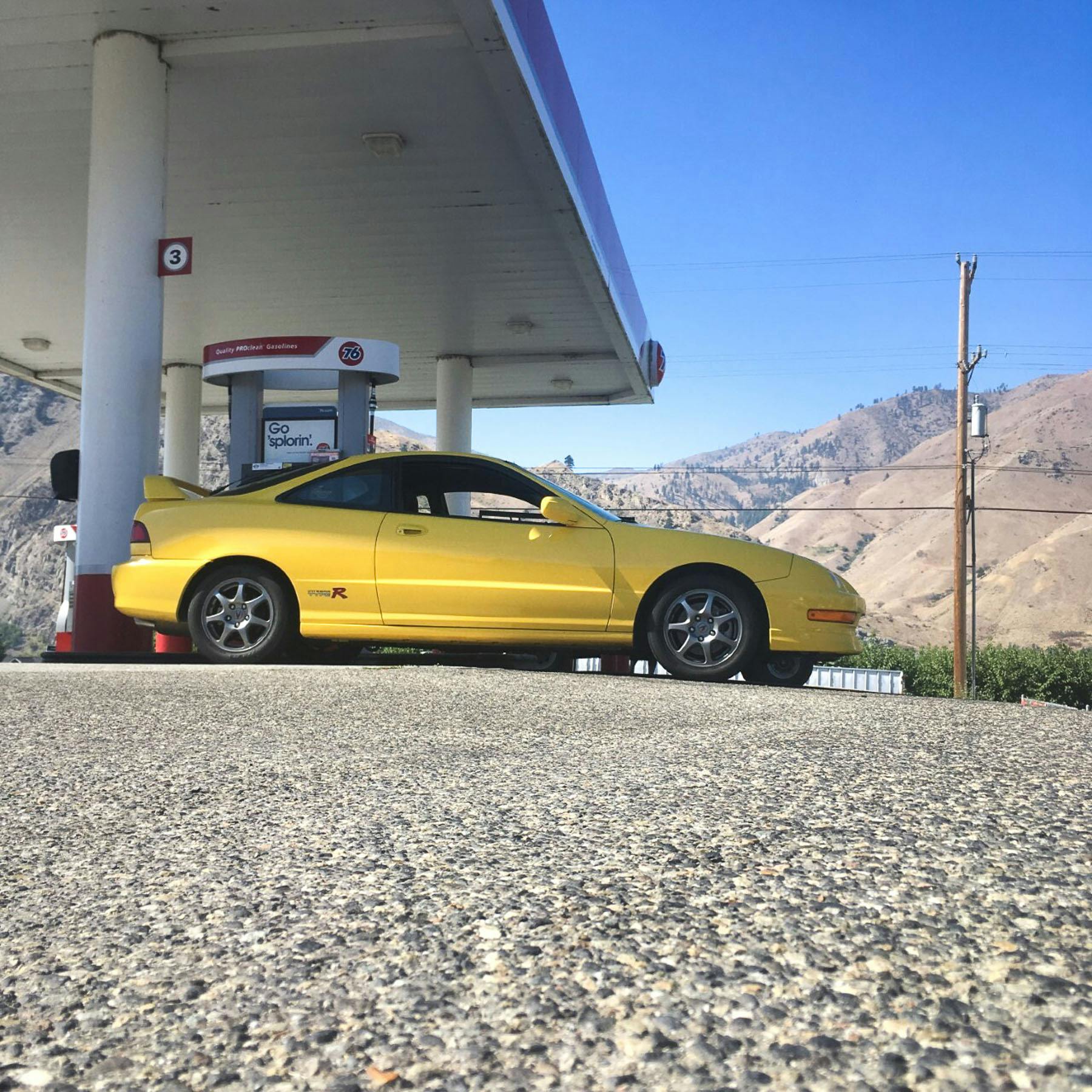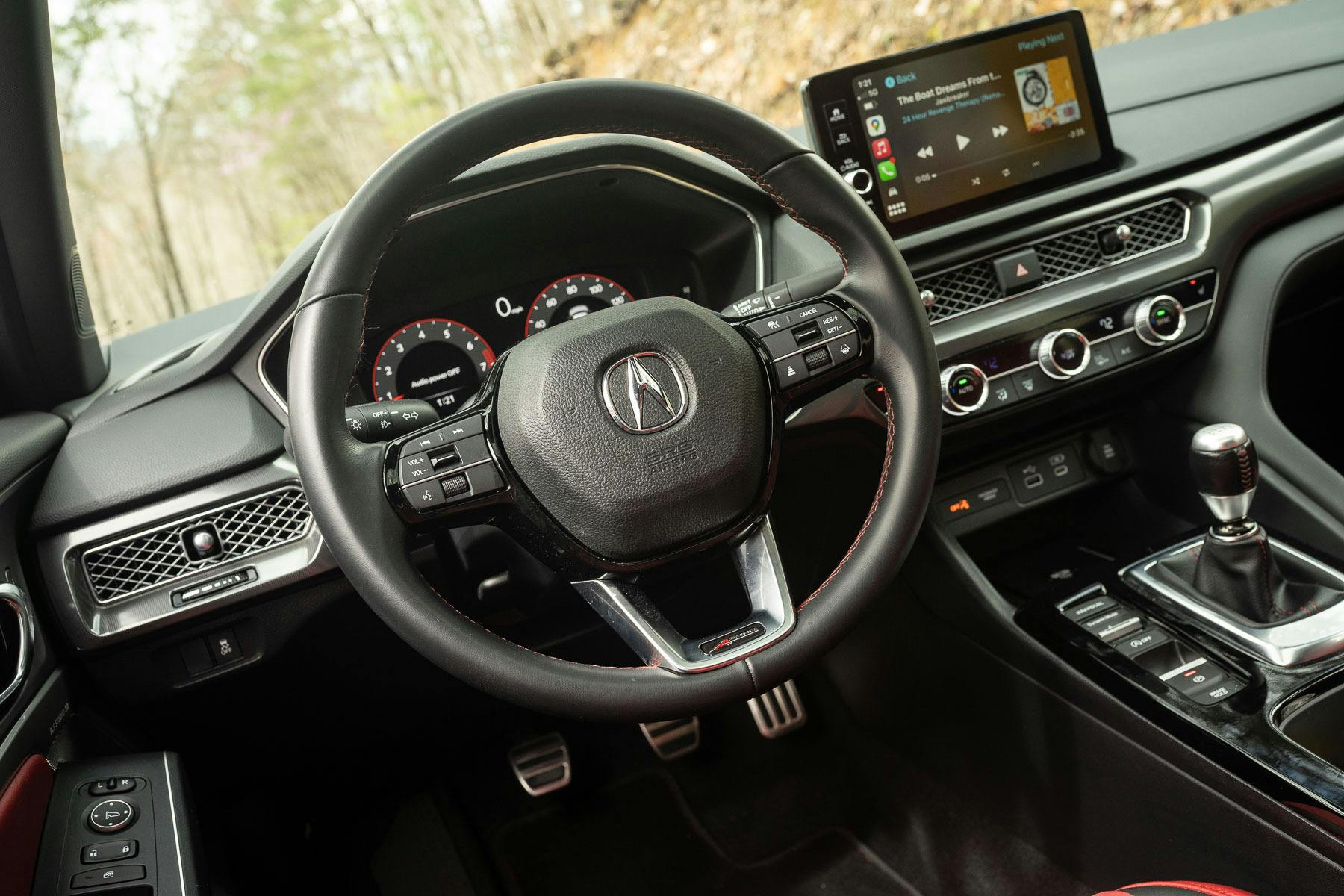Media | Articles
Smithology: Their existence answered enough
Thoughts from an Acura, but not that Acura, on a back road in the Smokies, 45 minutes from my house, on a Tuesday afternoon in March.
***
It hit me as a teenager. I knew it meant something. Probably because of . . . all the meaning, I guess?
Imprecise language, but you get the drift. Tautologies are rhetorical slop—saying the same thing twice while saying nothing at all. But that, as they said in Airplane!, is not important right now.
What is important: I drove the new car this week. It did not remind me of the old car.
Marketplace
Buy and sell classics with confidence
Should it?
Old is not new, as any child will tell you. Children also know names hold meaning, even seeming gibberish like “Integra.” Earlier today, I punched that word, that name of an Acura, into a search engine. The first link led to Wiktionary, the crowdsourced website not entirely unlike a dictionary. (Also not entirely unlike what would happen if the Merriam brothers and Noah Webster got blind drunk on 100-proof internet, but again, that’s not important right now.)
“Integral, whole, entire, intact,” it said. From the latin integer, a whole number, a thing complete in itself.
Fine, sure. But not the real meaning. Not B18C, DC2, Type R, GS-R, RealTime, Uehara, Championship White, a road car with an 8400-rpm redline and Formula 1 piston speeds, a homologation special remarkably cheap for years and now anything but.
Everyone meets life as if in their own movie, Tom Wolfe said, film stars for an audience of one. The figurative scripts and arcs at work are so personal, the notion holds, they often make sense only for someone of your exact background and beliefs. Which only makes it more wonderful, I think, how so many objects can appear in so many of our narratives for the same emotional reason and yet hold meaning so different and deeply personal to each.
The Integra debuted in 1986, a single model from Acura, Honda’s luxury division. When the name died in 2001, it was attached to well-rounded and charming little lineup, a two-door and sedan in a host of configurations. And yet, when the badge relaunched last year, some wondered why. We live in a world no longer bullish on affordable performance cars, those sensible, entertaining devices that dotted the roads before our global obsession with dumpy-looking SUVs and crossovers. (“Honey! The Blobbersons next door just got that new Tallheavy 5000! I love the cellulite folds in the rear fender! You wanna head to the dealer, check it out?)
Skepticism was logical; cars like this no longer sell. And yet the hot-takers and YouTube knee-jerkers spat irrelevant pap: Is it a “real” Integra? (Moot question, shades of the Mustang Mach-E.) Boo-hoo, a four-door! (Just like that first Integra, in ’86.)
Most of all, they babbled, would it live up to the history blah blah can we go home again?
First off, you can’t. Another Wolfe literally wrote a book about it.
Second, that book holds one of my favorite lines: “I have to see a thing a thousand times before I know it once.”

For most people, Integra history means one car. Not that ’86 model, which was basically a sportier, luxed-up Honda Civic. In the late 1990s, America was gifted the Integra Type R. That machine was essentially a faster and snortier version of the third-generation Integra, 1994 to 2001, which was, again, essentially just a Civic. While also so much more.
The R in the badge stood for racing. Boring etymology, but the car was a performance Honda in everything but name, heir to a long heritage of high specific output. From 1998 to 1999 and 2000 to 2001, this country’s Acura salesmen hawked, and were largely mystified by, an odd duck. Into a budget-oriented lineup of leather and comfort fell a raw and purpose-built track special, all vibration and noise.

For just under $24,000 in 1998—some $7300 more than a base Integra, or $10,000 more than a base Civic—you got 2500 pounds, no transmission beyond a six-speed manual, 195 hp, and that 8400-rpm, naturally aspirated, 1.8-liter twin-cam four.
A base Volkswagen Golf cost $13,500 that year. A loaded Toyota Camry was twenty-five grand. But those cars came with standard air-conditioning. They did not turn in like now or wear teeth-rattling dampers and a cockpit made louder by judiciously deleted portions of factory sound deadening. They certainly did not have that little furymite of an engine, with its sewing-machine idle and cam saddles like bridge abutments. Competition devices built from their bones did not end up among the winningest production-based race cars in American history.
Which means a high-school version of your narrator did not read far too many magazine stories about their unlikely and giant-killing radness, drawn like moth to flame, nor did he watch them race on TV weekend after weekend, wanting their punky little snort straight into a vein.
Every car is a story of people. When the ITR hit America, its chief engineer, Shigeru Uehara, had worked at Honda for almost 30 years. A quiet and thoughtful man, he was known for chassis tuning, had been project leader on the Honda/Acura NSX, would later sign off on Honda’s marvelous S2000 roadster.
I met him once, toward the end of his career, at a press event at Mid-Ohio. A translator asked for questions. I offered something about handling philosophy—how the man’s work had always seemed dialed without care for idiots at the wheel.
Uehara answered in Japanese. When he finished, the translator looked over, brow furrowed.
“He says he likes cars that . . . is this a phrase in English? ‘Turn from the back?’”
I smiled. Yes, I said, it is. A few feet away, Uehara nodded, smiling graciously, as if our chat had done him a favor.
Years later, after the great man had retired, I called his former PR minders, requesting an interview for a project. Sorry, they told me, Mr. Uehara no longer speaks with media, and especially not about himself. He had not built those cars for his own benefit, he said, felt their existence answered enough questions.
Three thousand, eight hundred and fifty Integra Type Rs were sold in America. Even in period, Acura hinted at the car’s status as loss leader, a bald stab at sexing up an anodyne brand. More important is how the ITR almost certainly locked the sales of tens of thousands of ordinary Integras, used and new. Countless people saw one in print or in a dealer’s front room, then bought the closest thing they could swing.
Naturally, when that new Integra met my driveway, a test car on loan, I thought about the one I sold. It was Phoenix Yellow, a 2001 model, bone-stock save Japanese-market Recaro seats. I owned it for single-digit years and said goodbye 18 months ago but loved every minute, wished I had bought one sooner. We did track days in the rain, went on daylong back-road rips, drove nearly the entire length of the Pacific coast in a weekend. Everything you’re supposed to do with a car like that.
Emotional stakes are never easily justified. A friend in PR at a major automaker once told me that he loved meeting customers at cocktail parties, the people who actually bought his product. The only problem, he said, was how most of those folks asked the same two questions:
1. Why can’t you put the cupholder where I want it?
and
2. Remember how you made Car X once? Why can’t you do that again?
Simple asks, but the answers lie in the often baffling complexity of product design in a heavily regulated industry. Not the easiest topic for highballs. Critically, however, each of those questions references the pull of a believed ideal. A solve for some perfect golden center, whether that means revisiting one from your past or simply tweaking the present.
Funny how we never do this with art. If Beethoven was still alive, only a fool would beg for another Ninth Symphony. Even if we got one, the new work wouldn’t swell with the same beauty, because it didn’t come from the same organic and honest moment.
I could expound here on why the old car hit me as it did, but the reasons are irrelevant. Only the how and when matter.

Before I sold the yellow ITR, I took it to the mountains near our house. The day produced photographs and a piece of writing on this site. Naturally, when the 2023 model showed up, I went back to those mountains, mostly from habit.
This was an A-Spec Advanced model, 200 hp and 3100 pounds, a clutch pedal and a six-speed manual. A tastefully done and pleasant thing, not a Type R by any means but not supposed to be. It presented mostly as a more comfortable Honda sport sedan—what executive editor Eric Weiner called “a damn good luxury Civic Si.” Which is almost, but not quite, how ordinary Integras once felt.
After maybe an hour of driving, I ended up on the road where I photographed the ITR. Same corner, actually, no plan to stop, it just happened. Before I knew it, I was standing in the woods, stepping this way and that, trying to line up my phone camera just so. I had taken a quick snapshot of the yellow car that I particularly liked, and so I stood there with that A-Spec, casually trying to repeat the effort.
A few indifferent results later, I grew frustrated, then caught myself. I slipped my phone back into a pocket, chuckling a little as I climbed back into the car.
The new Integra is the new Integra. The old Integra was the old Integra. I don’t really care how they differ, and while the new one left me a little cold, there’s now a new Honda Type R. I drove that car recently and loved it, but I couldn’t help thinking how fast and small imports don’t mean what they did in the 1990s.
Which is fine, of course, because we don’t live there anymore, probably wouldn’t like it if we did.
Integer. Complete in itself.
Fits, really.







































Great read, my favourite part:
Sorry, they told me, Mr. Uehara no longer speaks with media, and especially not about himself. He had not built those cars for his own benefit, he said, felt their existence answered enough questions.
As usual Mr Smith, hit the nail on the head.
I recently sold my 99 WRX, a car I’d owned for way longer than I originally planned. And while I loved every minute with that car and miss it terribly, I don’t want another one.
Also, I wish I had bought that DC2R when I was 21. I made a number of bad decisions that year, buying a different VTEC Honda because it might be nicer to drive to work was the biggest
I miss the Integra and the old Honda. That company doesn’t exist. We should be grateful a turbo 4 Type R is on the way because it’s only a matter of time before every Honda product is as boring as the new Accord. Honda just doesn’t speak to me anymore. I would have kept the Type R for the rawness and directness that it represents.
The wife had a ’88 5-door Integra when we started dating. Tan color, manual 5-speed. Pretty good little car. Very utilitarian with the hatch and fold-down rear seats. FWD wasn’t really my jam, but the car had it’s attributes. We probably would have kept it for longer had it not been rear-ended in ’99. Damage to bumper and tail panel so that hatch wouldn’t latch made it an insurance company total. She just HAD to have another Acura, so we replaced it with a ’92 Vigor. Also a stick, but nowhere near as useful a vehicle. Because it’s a stick though, I can’t bring myself to sell it. I’m still driving it to this day.
@MoparMarq My brother owned a ’92 Vigor. He loved it and as a result I bought a ’93 Vigor GS. Loved that car, but it really didn’t get much respect. To be honest the backseat was so tight that while technically a four door, the rear seat was best reserved for children. I drove that Vigor for 8 years and 110K miles before trading it in for a 2001 TL, and after that a 2006 Acura RL (the one that introduced SH-AWD). Loved both, especially the RL. The tech in that car was impressive for it’s time and it all worked. IMO, it was better than the tech in the 2012 CTS-V that replaced it.
The SH-AWD was pretty impressive and what a blast it was when I actually learned how fun it was accelerating that car into curves. The more you pushed it, the more it seemed to hunker down. It was never a huge sales success though. Power was good for the time, but it never did get much support from Acura corporate. It was a Japanese design that was foisted on them and they never really got behind it.
After that the RL got weirder (with that snaggle tooth beak), more bloated and irrelevant.
As for that ’92 Vigor that my brother bought, he ended up selling it a couple years later to my father. He and my mom had a ’91 Cadillac Brougham d’Elegance that they purchased new. As blue-collar immigrants, it was their dream purchase and the one and only new car they ever bought, but rarely drove.
My dad LOVED that Vigor and drove it all the time, always over the Cadillac, right up until the day he died way too young at 60 after a bout with cancer.
My mom couldn’t bring herself to sell the car. A couple years after my dad passed she bought a condo in Florida and moved that Vigor from Chicago to Florida, where she still drives it to this day when she is there. It has just under 100K miles on the odometer. She is constantly getting stopped by people who want to know about the car, what it is, how old it is and if she wants to sell it. A year ago I was down there and I drove it during my stay. I was amazed at the attention it got when I pulled into the valet of a local restaurant with a group of young and old gathered around it. Parts are beginning to get tough to find, and even the local Acura dealer seems to not know how to service it, but she won’t sell that car.
Seems like that old Acura is getting the attention it didn’t really get when it was new.
Funny how that often seems to often be the case.
Anyway, great article. I remember those ITRs, never was fortunate to drive one, but drove a few more pedestrian Integras during the rare times that my Acuras went in for service.
Thanks Sam for the trip down memory lane.
I well remember and miss the Speedvision Touring Car Series and the dominance of those red and white Integras. I also remember Pierre Kleinubing door slamming a guy into the wall on the back straight at Mosport at full acceleration. I still think it was one of the dirtiest moves I ever saw a race driver perform .
I think for many of us who understand Thom Gunn’s maxim, “One is always nearer by not keeping still,” your splendid yellow Integra might be the perfect vehicle. When you first look at it, even in a photograph, it presents as “The Platonic Automobile.” It requires a only a driver and a vista. Back when you set it free, so to speak, I wondered how you would get by in its absence. Enter the 2002 tii, a/k/a “White Rat.” Not so Platonic, perhaps, but some of us appreciate imperfection as long as it invites us to collaborate and has no need for paying homage. Whatever. I wish you still had the yellow Integra with the red “R”.
Superb…just superb
Spouse had a first- gen Accord, then purchased her ’90 Accord hatch.
Auto but she loved it. Great handling, braking and steering for our Los Angeles ‘road runs’ into “the city” and back late at night…
Great car and the automatic was great. Sorry we missed the “R”…
Perhaps someone can explain to me why the high-revving 4-valve Integras were undersquare with 75 x 90 bore and stroke or 81 x 89 or 81 x 87 in the 1.8s, while Legends were oversquare at 84 x 75 or 87 x 75. It confused me at the time and still does!
Bore more than stroke = oversquare, opposite is under.
75 x 75 would be a square bore.
—-
Engine theory seems to waver, but generally oversquare = short stroke = more low speed torque, efficiency. Durability seems to be a topic of debate between the two camps.
under square is high revving torque curve. Fuel thirsty, more emissions –if you believe some sources.
Other sources suggest it is only part of the overall package that leads to a result. Maybe some experts will chime in…
I purchased a 1990 Integra LS after an impulse test drive of the 5-speed manual with 130 hp. I knew it was just an upscale Civic. Driven only one year, I traded it for a 1990 Nissan Maxima SE, a family car I would own 16+ years. The Integra seats sat too low for my liking, something I realized after the ½ hour drive home from the dealership – but it was too late; the papers had been signed. I raised the driver’s seat using grade 8 hardware and drove it a year so I would not take too large a loss on the trade in. It would be 11 years before I would own another Honda, an S2000!